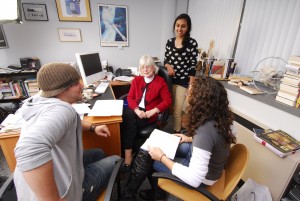Carol Senf
Living in a world that purports to value scientific predictability while teaching (for 32 years) at an engineering school, it’s sometimes hard to justify why I value the Gothic and argue that it is even more essential today.
It’s not because I’m besotted by tradition though I am fond of the architecture often described as Gothic. Originally built in Europe between the 12th and the 16th centuries and later revived in the 19th, Gothic architecture is identified by the ribbed vault and the flying buttress, both of which allowed for dramatic interior spaces that are literally filled with light. Think Notre Dame in Paris, the York Minster, or Westminster Abbey. Of course, one need not go to Europe for a Gothic fix: the architect who designed the Tech Tower and its sister buildings at Agnes Scott and Clemson echoed the aspiration evident in medieval Gothic, as did the architect for the postmodern building on West Peachtree formerly known as the IBM Building.
The Gothic as a way of seeing the world originated at the end of the eighteenth century, when a sense of scientific certainty was beginning to emerge.
However, Gothic or The Gothic is associated with other arts as well. Not only does Gothic refer to an extinct Germanic language, but it also characterizes several kinds of script or typography: 1) A script used in Western Europe from approximately 1150 into the 17th century, and 2) sans-serif typography, such as Ariel or Helvetica, often used for dramatic headings. And to make matters even more complicated, there’s also Gothic music, a type of rock and roll, and Gothic clothing—think Wynona Ryder in Beetlejuice or almost anything by Tim Burton.
While I’m fond of Gothic architecture, having never met a Gothic cathedral I didn’t like, and use Gothic type regularly, they aren’t what I think of when I argue that the Gothic is essential in the modern technological world. Indeed the Gothic as I see it encompasses some of the previous examples I noted, being a way of describing (or attempting to describe) or responding to a world that cannot be fully explained by science or mathematics, a world that is large enough to include the mysterious, the liminal, and the terrible.
The Gothic as a way of seeing the world originated at the end of the eighteenth century, when a sense of scientific certainty was beginning to emerge. I suspect that the Gothic was, even then, a counterbalance produced by writers and thinkers who felt limited by such a confident worldview and recognized that the power of the past, the irrational, and the violent continues to hold sway in the world. Two hundred (and more) years later, there’s much that science cannot explain and problems that technology cannot solve. Some days it’s easy to feel paralyzed by forces beyond our comprehension and beyond our control.
Students “get” Stoker’s message about the limitations of science. Scientists and programmers, Tech students know there are things they do not understand and over which they have no control.
To get a handle on the Gothic, it helps to go back to what is arguably the first “modern” example, Horace Walpole’s 1764 novel, The Castle of Otranto, which he subtitled “A Gothic Story.” Walpole noted that he wanted to combine elements of the medieval romance, which he found too fanciful, and the modern novel, which he believed was limited by the very ordinariness of realism. Hence he invented an antiquarian who discovered the fragments of an ancient manuscript and set it in a medieval castle. That manuscript tells of a villainous aristocrat who will do anything to gain power and of several persecuted female characters who attempt to elude his control. Writers, filmmakers, and video game designers often adapt these conventions. Thus we have come to expect persecuted heroines, inscrutable villains, supernatural forces, and decaying medieval structures in works described as Gothic.
An easy formula to adapt, one might say, but the Gothic has been well adapted by Mary Shelley (Frankenstein), the Brontes (Jane Eyre, Wuthering Heights, and The Tenant of Wildfell Hall), Henry James (The Turn of the Screw) and Bram Stoker (Dracula), not to mention Poe, Faulkner, and Stephen King many of whom adapt the conventions to explore their own worlds and add a convention (that of multiple narrators as if to remind readers that no single human being has the whole truth).
Stoker brings a monstrous figure from the medieval past to London, the heart of Empire. Juxtaposing past and present, Stoker opposes this figure with everything that modern science and law have to offer—the power of combination—and tracks Dracula to his Transylvanian lair, the very name “beyond the forest” evoking mystery. Using the tools of Empire, the kukri knife and the Bowie knife, Stoker’s “Crew of Light” seems to destroy Dracula, and a brief epilogue shows them seven years later at the site of their victory. However, the easy victory fails to satisfy. Readers may remember Van Helsing’s observation that nothing manufactured by human beings could destroy the vampire, and evidence from the manuscript suggests that Stoker contemplated destroying Dracula’s castle at his death, but someone—Stoker or an editor—excised the paragraph in which the castle is destroyed. Having the vast ruined castle loom over the human characters is somehow more satisfying, as it suggests that the mysterious forces Dracula represents by are somehow more powerful than contemporary science and technology, which often fail despite the smug self-assurance of both scientists and representatives of the legal system.
Students “get” Stoker’s message about the limitations of science. Scientists and programmers, Tech students know there are things they do not understand and over which they have no control. Much as they want easy answers, they see complexity around them. Emphasizing multiplicity and complexity is what Gothic does best. Because I see my job as reinforcing that suspicion of easy “one size fits all” solutions, I believe that the Gothic is essential to our technological world.

